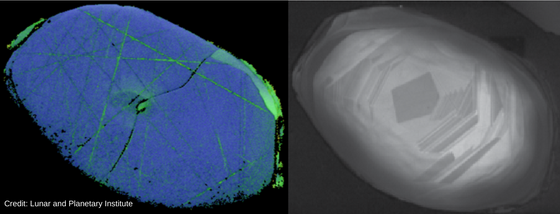
Electron backscatter diffraction and cathodoluminescence images of the culprit zircon grain from the Jack Hills of Western Australia Credit: Lunar and Planetary Institute/T. Erickson
A study out this month in the journal Geology led by researchers from Curtin University in Western Australia cautions researchers to be wary of some ancient zircon ages. Age analyses of a zircon grain from the Jack Hills of Western Australia record a concordant apparent U-Pb age of 4463 ± 17 million years old, which would make this the oldest Earth material. However, careful ion imaging of the distribution of Pb in the crystal structure shows that this grain crystallized a ca. 4.3 Ma and subsequent heating mobilized some of the Pb causing a false age spectrum. These results highlight the caution that must be taken when assessing the isotopic systematics of the oldest material on Earth.